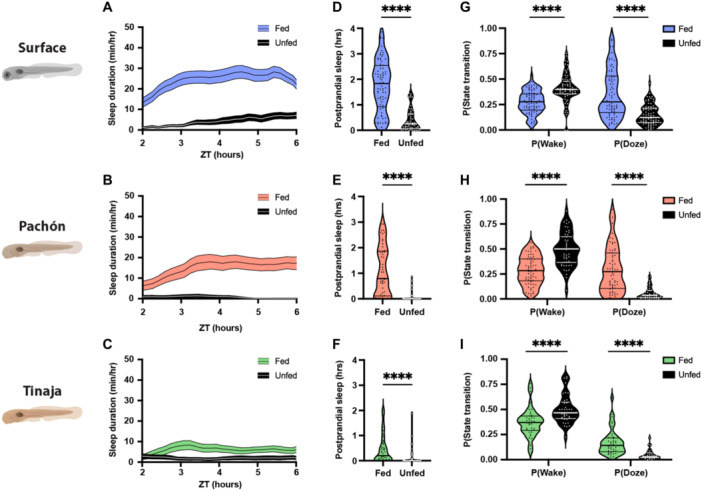Figure 4.

Feeding results in robust increases in sleep duration in larval surface, Pachón, and Tinaja populations of Astyanax mexicanus. (A–C) Four‐hour sleep profiles comparing the sleep of fed (colored) and unfed (black) individuals in each population. Lines and error bars represent the mean ± SEM. (D–F) Fed fish sleep significantly more during the 4 hours following feeding than unfed fish, regardless of the population. (D) Surface: Mann–Whitney U = 524, n fed = 77, n unfed = 55, p < 0.0001. (E) Pachón: Mann–Whitney U = 310.5, n fed = 52, n unfed = 47, p < 0.0001. (F) Tinaja: Mann–Whitney U = 546.5, n fed = 45, n unfed = 49, p < 0.0001. (G–I) Fed fish are less likely to wake while asleep, and more likely to fall asleep while awake, than unfed fish. (G) Surface: P(Wake) Mann–Whitney U = 1317, n fed = 77, n unfed = 76, p < 0.0001; P(Doze) Mann–Whitney U = 1347, n fed = 77, n unfed = 75, p < 0.0001. (H) Pachon: P(Wake) Mann–Whitney U = 663, n fed = 66, n unfed = 52, p < 0.0001; P(Doze) Mann–Whitney U = 802, n fed = 69, n unfed = 52, p < 0.0001. (I) Tinaja: P(Wake) Mann–Whitney U = 369, n fed = 40, n unfed = 38, p < 0.0001; P(Doze) Mann–Whitney U = 229, n fed = 40, n unfed = 34, p < 0.0001. Horizontal lines represent quartiles. Asterisks represent significant differences between fed and unfed groups.
